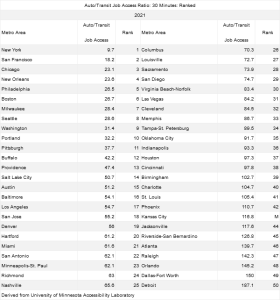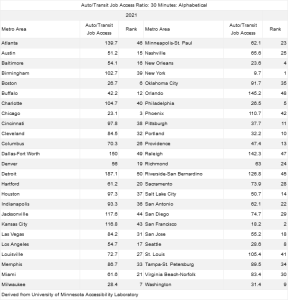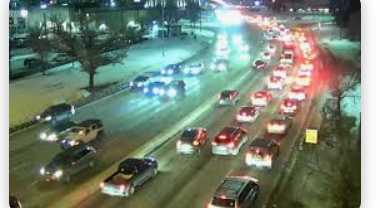What a difference the remote work revolution has made. The University of Minnesota Accessibility Observation auto and transit access data for 2021 (the latest) indicates a huge improvement in 30-minute job access for the average resident of 50 metropolitan areas that exceeded 1,000,000 residents in the 2020 Census (the report excludes six metropolitan areas that also had more than 1,000,000 residents in the 2020 census, including Fresno, Grand Rapids, Honolulu, Rochester, Tucson and Tulsa). The improvement has occurred as the reduction in peak period automobile commuting has freed highway capacity.
The report made these salient points:
“…compared to pre-pandemic travel patterns in January 2020, the typical worker in 2021 in the Atlanta region could reach 82 percent more jobs; a worker in the Seattle area, 62 percent more jobs; in Houston, 50 percent more; and in Minneapolis, 42 percent more.”
“If we can take advantage of this and provide real alternatives to driving alone, we can keep congestion solved in our lifetime without freeway expansion.”
“Improvement in the auto network was greatest in cities previously most burdened with congestion. The 2021 data shows that morning commuters in Los Angeles and San Francisco could drive to more than twice as many jobs in the same amount of time as they could the previous January, prior to the pandemic.”
Overall, by auto, typical commuters can reach 45 million jobs within 30 minutes in 2021, a number equal to 54% of the jobs in the surveyed metropolitan areas, an increase of more than 50% compared to the 2019 figure. In contrast, the typical commuter could reach 1.2% of the jobs in 30 minutes by transit, an increase of almost 10%.
The 30-minute standard is being used widely. The latest data indicates that the overall average work trip travel time is 26.6 minutes, one way, in the United States.
Auto/Transit Job Access Ratio (30-Minutes)
The potential performance of autos and transit can be compared using the Auto/Transit Job Access Ratio.
The 30-minute Auto/Transit Job Access Ratio demonstrates the dominance of cars in US metropolitan areas. This ratio reports the number jobs that auto commuters reach per job reachable by transit in 30-minutes. Among the 50 metro areas, the median Auto/Transit Job Access is 64.2 (6,420 percent as many jobs accessible by auto as by transit) and the median was 75.3 (7,530 percent as many).
New York has the lowest auto/transit job access ratio of 9.7, indicating that the average commuter in the New York metropolitan area can reach 9.7 times as many jobs as the average transit commuter. In the New York metro, an average of 2,150,000 jobs can be reached in 30 minutes, compared to 220,000 by transit.
San Francisco has the second strongest transit access, with an auto/transit access ratio of 18.2. Chicago has the next highest transit access, with an auto/transit ratio of 23.1. Perhaps surprisingly, New Orleans ranks fourth with an auto/transit ratio of 23.6. Philadelphia rounds out. the top five, with an auto/transit access ratio of 26.5 The second five include Boston at 26.7, Milwaukee at 28., Seattle 28.6, Washington at 31.4, and Portland at 32.2. The metropolitan areas with the least transit access are Detroit with an auto/transit access ratio of 187, Dallas Fort Worth at 150, Orlando at 145, Raleigh at 142 and Atlanta at 140. Riverside San Bernardino has an auto/transit access ratio 127, Jacksonville is 118. Kansas City is 117, Phoenix is 111 and St. Louis is 105. The data is indicated in the two tables below.


Where for Transit from Here?
With this minimal transit use relative to the auto and especially in view of the huge transit market share losses since the pandemic, it would seem useful to rethink the role of transit.
Transit does well for work trips to the largest downtown niche markets (New York, Chicago, Philadelphia, Boston, Washington, and San Francisco), though pre-pandemic market shares are unlikely to be replicated in the future because of the popularity of hybrid and remote work, lower office occupancy and the likely improvement in virtual meeting technology.
The reality is that transit is not a substitute for the auto and there isn’t enough money to make it one. Professor Jean-Claude Ziv and I found that making the auto a genuine alternative to transit could be prohibitively costly, annually requiring the entire metropolitan area gross domestic product in some cases. This would leave nothing else for anything else.
It would be foolhardy to suggest that transit is an alternative to the auto (despite this having sbeen implied by federal, state, and local policy for decades of decline), In a non-utopian world, no reasonable increase in subsidies could make it so.
It may be best to identify the small areas within metro areas where transit could actually be an alternative to auto. This would be in neighborhoods where automobile ownership is particularly low, which, in most metros are also areas of greater economic need. Investing billions more to coax middle class commuters off the roads seems a daft approach given the realities.
First published here.
Wendell Cox is principal of Demographia, an international public policy firm located in the St. Louis metropolitan area. He is a Senior Fellow with the Frontier Centre for Public Policy in Winnipeg and a member of the Advisory Board of the Center for Demographics and Policy at Chapman University in Orange, California. He has served as a visiting professor at the Conservatoire National des Arts et Metiers in Paris. His principal interests are economics, poverty alleviation, demographics, urban policy and transport. He is co-author of the annual Demographia International Housing Affordability Survey and author of Demographia World Urban Areas.


